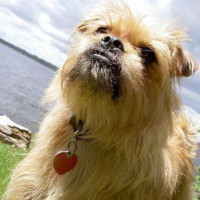Appearance of the Pugshire
|
| The Pugshire's appearance can vary considerably, with some resembling long-haired Carlins and others short-haired Yorkshires. As time goes by, the breed will develop a more uniform appearance, but for the moment, there's a lot of variation in appearance. Most will have rounded skulls and flat foreheads, with small, semi-erect ears hanging forward. A small amount of skin wrinkling can be seen at the top of the skull and between the eyes. Their eyes are a deep brown, giving them a serious, calm expression. Most tend to be less brachycephalic than their Carlin relatives, but their muzzle is often more squashed than that of the Yorkshire. Their small bodies are neat and compact, supported by short limbs. Their tail is usually curled over their back. A toy-sized breed, Pugshires reach heights ranging from 30 to 38 centimeters and weigh from 3 to 9 kilos. Most individuals will have a medium-length, straight, silky coat. Although the coat color is classic with a black face mask, members of a breed can come in many colors, including brindle, gray and black. |
Temperament of the Pugshire
|
| Magnificent pets, Pugshires are tolerant and fun-loving. They appreciate time spent with family members and are particularly fond of children. Always happy to be the center of attention, Pugshires are happiest when in a crowded room and surrounded by loved ones. Equally good with other dogs, the Pugshire is sociable and will usually be the life and soul of the party at any dog park or doggy daycare. Dogs that become devoted to their family, it's best to place this breed in a home where there's someone around most of the time, as they can get lonely otherwise. They will follow their master from room to room and are rarely content with their own company. Owners should be aware of the potential risk of separation anxiety, and should ensure that dogs are not excessively mistreated. Always the first to know if someone has arrived, the Pugshire will rise to bark at the first sign of a new host. This makes them superb watchdogs, as nothing escapes their notice. Because of their small size and good temperament, they wouldn't make a good defense dog. |
Needs and activities of the Pugshire
|
| Pugshires love to run, jump and play, and should be taken outside for at least an hour's exercise every day. If your dog doesn't get enough physical activity every day, he may become bored or anxious, and some dogs will develop bad habits such as aggression and excessive barking. This breed enjoys playing ball, agility training, swimming, long walks and spending time with other dogs at the dog park. As the Pugshire is small, it's possible to give it enough exercise indoors in bad weather, but it's best to take it outside at least once or twice a day. |
Maintenance of the Pugshire
|
| The Pugshire should be brushed at least once every three or four days with a brush or stiff bristle brush. Once a week, you should also take a metal comb and give your dog a thorough grooming, making sure to go under the neck, behind the ears and under the legs. You can wash them with a mild dog shampoo if necessary, but not too often as this will dry out their skin and cause irritation. At least once a month, you should trim his nails and clean his ears. Also, clean their teeth once a week to prevent tooth decay. |









 English (United Kingdom)
English (United Kingdom)